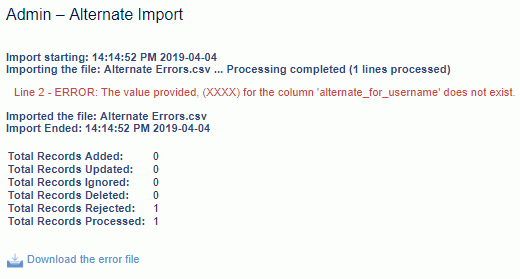|
|
|
|
This feature allows for the importing of Project level Expense Type information into the Unanet system.
Within one expense type import file, an Administrator can import expense type data for one to many projects, across multiple organizations if desired. The Project Manager version of the import restricts the importing of expense type data to the specific organization/project in which the Project Manager is accessing the project expense type.
This screen is available to users having any of the following roles: Administrator, P&R Administrator (and Project Manager has access to a project level version).
This feature is available with any Unanet edition.
Topics covered on this help page include:
Import File Record Layout (field by field descriptions)
Import File Format (note about csv layout and option to import a subset of columns using header values)
Excel Template (spreadsheet template containing column headings)
Import Screen (invoking the import via the user interface)
IMPORTANT: Note that there are multiple places within this documentation that say you MUST use double quotes for the strings in your import. If you are working in Excel, Excel will provide the double quotes and thus you do not need to add them in manually. Manually adding double quotes within Excel would result in multiple sets of double quotes in the resulting .csv file and thus cause an error (should you attempt to import that resulting file). Please see Excel Tips for more information.
|
|
|
Field Header Name |
Required/Comments |
|
1 |
A |
Expense_Type |
ALWAYS REQUIRED. This entry uniquely identifies the expense type being imported. This value must match an existing Expense Type value defined in your system. If the Expense Type you are trying to import does not already exist in on the master list of expense types, the entire record will be rejected. Do note that you are allowed to import expense types that are inactive on the master expense type list. |
|
2 |
B |
Project_Org_Code |
ALWAYS REQUIRED. This code uniquely identifies the Organization to which the project belongs. This value must match an existing Project Organization Code value defined in your system. If the Organization you are trying to import does not already exist in the database, the entire record will be rejected. |
|
3 |
C |
Project_Code |
ALWAYS REQUIRED. This project code identifies the project to which this Project Expense Type belongs. This value must match an existing Project Code value defined in your system. If the Project you are trying to import does not already exist in the database, the entire record will be rejected. |
|
4 |
D |
Markup |
This field is optional and can be used to supply a project specific expense type markup percentage value. You can use the special tag !BLANK! to remove an existing entry in this field. This field accepts a numeric value up to 3 positions to the left of the decimal and 2 positions to the right (-999.99 to +999.99). Do not include the % sign within the file. |
|
5 |
E |
Delete |
This field can be used to trigger the system to delete a project expense type entry. To delete a project expense type, you must include the text string !DELETE! in this field. |
Note: Check out the Unanet Data Model for specific field data types, lengths, and other attributes. Navigate to Unanet Support and search for "Data Model".
The file to import must be saved in a comma delimited format. The fields can be enclosed in double quotes -- which would be particularly necessary should the data being imported contain commas.
If you are not using the default column layout sequence as defined above, you must include a header record (prefixed with an asterisk *), containing the column Header Names for those columns you are including in the import file (to indicate what data is contained in each column). The specific Header Names for each column are listed in the table above.
Example:
*Expense_Type,Project_Org_Code,Project_Code,Delete
exp_type1,org1,project1,!DELETE!
You can create the comma delimited import file with any number of tools. For those interested in using an Excel spreadsheet to create the file, you can download ![]() an Excel Template with predefined headers.
an Excel Template with predefined headers.
See the Excel Tips regarding the use of double quotes and more.
The Import Project Expense Types screen simply looks like:

|
Field |
Description |
|
Type of Import |
Select the appropriate import type from the list of available types of imports. |
|
File to Import |
Enter (or browse for) the file that you would like to import. |
|
Output Options |
Specify the level of detail included in the output. |
The import process is triggered by pressing the Import button. All Warnings and Error messages are written to the screen and can then be saved if desired. While some line items may be found invalid and rejected, the remaining line items will be successfully imported and saved in the database. The rejected line items will be written out to a file on the Unanet server as well as displayed at the bottom of the Import results page. The rejected record file name will be the import name (from the Type of Import drop-down on the Admin>> Import page) , concatenated with a space and "Errors.csv" (e.g., Item - Master Errors.csv, Alternate.csv, etc.). The file will be placed in the Unanet temporary directory (which is defined by the Temp Directory (Fully Qualified Directory Name) (unanet.temp_directory) Unanet property). You can also click on the Download the error file link at the bottom of the Import results page (sample image follows).
